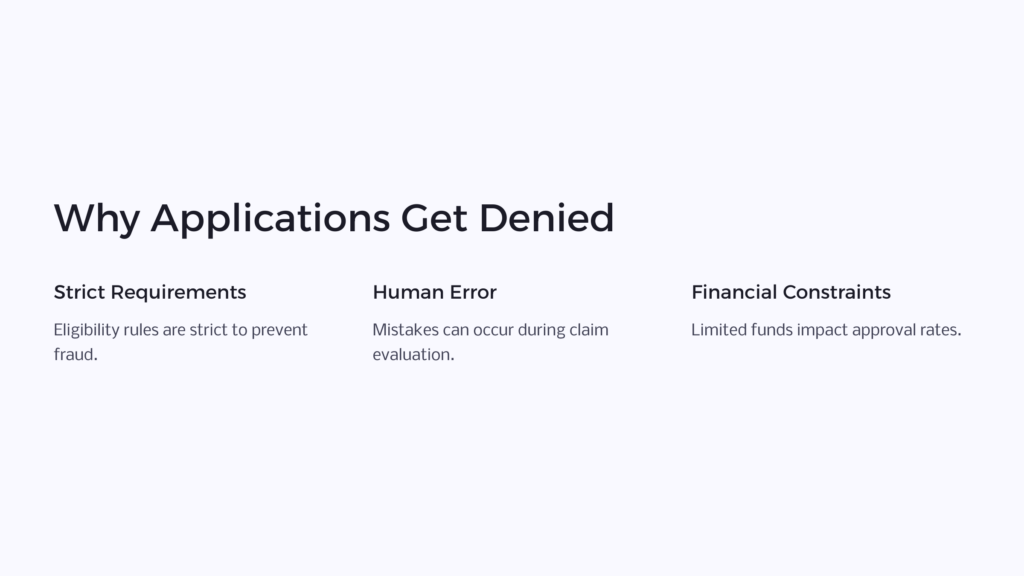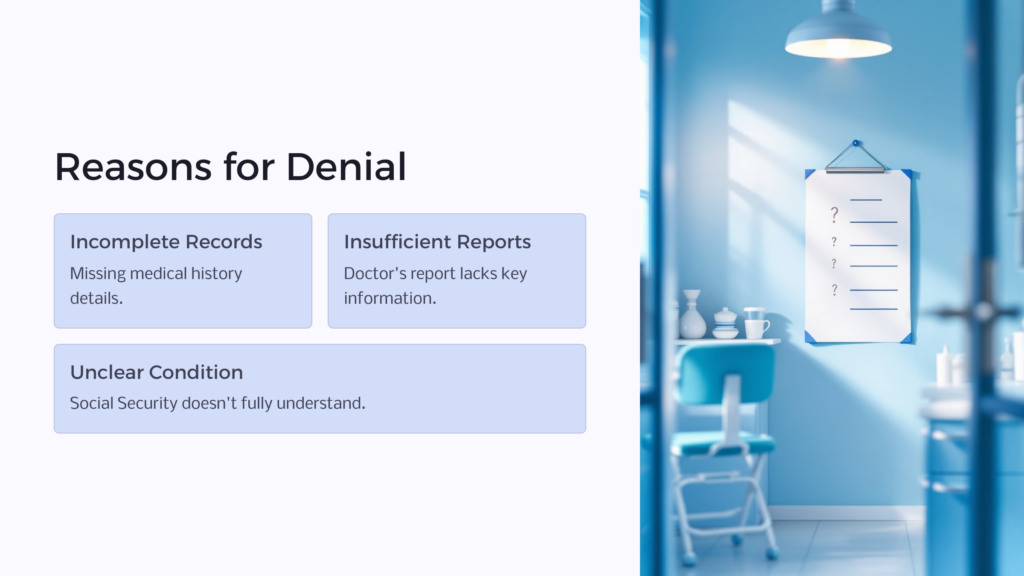No matter how much thought, time and effort you’ve put into preparing your initial application for Social Security Disability benefits, don’t be surprised if it’s denied by the Social Security Administration. Over 70% of them are.

To help you decide what to do next, we’ll explain why most initial applications are denied, how you might deal with the denial, and the sequence of options the SSA offers to applicants who wish to contest their denial.
Social Security Disability (SSD) Appeal Process for a Denied Application
The SSA wants to provide Social Security Disability (SSD) financial aid to every deserving applicant. But for several reasons—the huge number of applicants, the constantly eroding financial condition of the Social Security Trust fund, the need to prevent fraud, and the agency’s desire to judge every application in the same, impartial way—eligibility requirements are strict and are followed “to the letter” nationwide.
Even so, SSA realizes that those involved in evaluating claims are “only human,” and human error is possible at any stage of the eligibility evaluation process. Possible, too, are other medical or non-medical reasons for a turn-down, but many can be dealt with once you know what action to take. That’s why, if you’ve been denied benefits and believe you qualify for them and you know you need them, don’t give up. Challenge the decision, either by yourself or with the help of a law firm with SSD experience.
Important: If you wish to appeal, you must make your request in writing within 60 days from the date you receive the SSA’s letter of denial. Do so even if you have only some, but not all, of the new required information.
Step 1: Request for Reconsideration

After the SSA denies your initial application for benefits, or terminates your current benefits, the first step is to request your information be reviewed again. The Disability Determination Services will employ a medical consultant and claims examiner to evaluate all the evidence you provided.
You can also submit new evidence at this stage that may help your case, such as records of more recent medical exams or treatment. The reconsideration process can take several months, and around 10-15% of all appeals are approved. You can get started by filing for reconsideration online, or submitting form SSA-561-U2 to your local social security office.
Step 2: Administrative Law Judge (ALJ) Hearing
If your request for reconsideration is denied, you can request a hearing before an administrative law judge within 60 days of receiving your denial letter. ALJs work with the SSA Office of Hearings Operations, either upholding or overturning decisions to deny or retract disability benefits.
ALJs grant almost half of all the claims that reach them, which could mean you have a better chance of success with a hearing, even if you’re denied reconsideration. Notably, however, it’s often a good idea to hire a disability lawyer to help you present your case. A vocational expert can also testify on your behalf if necessary.
Step 3: Appeals Council Review

If you are still denied your claim after the disability hearing, you can request a review from the Appeals Council, either by submitting Form HA-520 or making an online request. The Appeals council has the discretion to deny, grant, or dismiss your review request.
There’s no hearing at this stage. Instead, the Appeals Council simply looks for flaws in the ALJ’s decision before a review is granted. If they do review your case, it may be sent back to the ALJ for another examination.
Step 4: Federal Court Review
Finally, if none of the previous actions are successful, you can file a lawsuit in District Court. You’ll need an attorney representative at this stage. Federal judges often hear these cases without juries, and will review the case for any legal errors. District court judges generally only reverse ALJ and Appeal Council decisions in a small number of cases. However, they can send cases back to Social Security for further examination if the SSA were found to overlook important information.
Levels of the Social Security Disability Appeal Process
In most states there are four levels: Reconsideration, Hearing, Appeal and Federal court review. In other states where the Disability Service Improvement program has already begun, there are three levels:
- Hearing by an administrative law judge (ALJ)
- Review by the Appeals Council
- Federal court review
Reconsideration
This is a thorough and independent review of your case, based on the evidence you submitted for the initial determination plus any further evidence you submit in connection with the reconsideration. When the review is of a medical denial, it is done by a member of the state Disability Determination Services staff who has been trained in handling reconsiderations and who was not involved in the initial decision you’re appealing. Most reconsiderations involve a review of your files without the need for you to be present.
You must file Form SSA-561-U2: Request for Reconsideration within 60 days after receiving the notice of denial. However, if you miss the deadline, you can still request a reconsideration if you include a written statement of “good cause” containing one or more good reasons for missing it. For example: A severe disability, particularly mental illness, which prevented you from contacting the SSA; the loss of important records due to fire or theft; your incarceration; illiteracy; inability to understand or read English; or non-receipt of a decision due to homelessness or hospitalization.
Regardless of when you send it, you should present any new evidence you have that may prove the original determination was incorrect. You’ll need to complete and sign two other forms: SSA-3441-F6 — Reconsideration Disability Report and SSA-827 — Authorization to Disclose Information to SSA.
Hearing
If you disagree with the reconsideration decision, you may ask for a hearing, to be conducted by an administrative law judge (ALJ) who had no part in the original decision or in the reconsideration of your case. The hearing is usually held within 75 miles (or longer in some states) of the applicant’s home. You will be notified of the time and place of the hearing.
Before the hearing, you may be asked to submit more evidence and to clarify information about your claim. You may look at the information in your file and give any new information.
At the hearing, the ALJ will question you and any witnesses you bring. Other witnesses—e.g., medical or vocational experts—also may provide relevant information, and you’re allowed to question them.
In certain situations, your hearing may be via a video conference rather than in person; if so, you’ll be notified ahead of time. A video hearing may be more convenient for you. Often, it can be scheduled faster than an in-person appearance and/or it may be held closer to your home, making it easier for you to have witnesses or have other people accompany you. Either way, in-person or by video, it is usually to your advantage to attend the hearing in order to explain your case and answer any questions.
If you’re unable to attend a hearing or don’t wish to do so, you must tell the SSA why, in writing, ASAP. Unless the ALJ believes your presence is necessary to decide your case and requires you to attend, you won’t have to go. Or the SSA may be able to change the time or place of your hearing. It is to your advantage to attend; therefore, we recommend making every effort to do so.
After the hearing, the ALJ will make a decision based on all the information in your case, including any new information provided. You’ll be sent a letter with the judge’s decision. If it’s another denial, and you’re sure you’re eligible for SSD benefits, then you can ask for an Appeal.
Appeal
At last count, the SSA’s Appeals Council consists of about 70 administrative appeals judges, 56 appeals officers, and several hundred support personnel. The Council may grant, deny, or dismiss a request for review. If it grants the request for review, it will look at the entire decision, not just the part you disagree with. “If our decision was wrong,” the court promises, “we will change it.” It will either decide the case or return (“remand”) it to the ALJ for a new decision.
But don’t expect a quick decision by the Council because the council receives more than 100,000 requests for review each year. If you assume each request was seen by a judge — not only by an appeals officer or a staff member — that’s an average of 1,814 cases per judge per year. If each judge worked 250 eight-hour weekdays per year, that’s an average of 7.26 requests per day, or close to one per hour. With its financial status the way it is, don’t expect the SSA to hire a lot more judges in the near future.
Federal court review is the last level of the appeals process. This level of appeal is actually a civil lawsuit you would file against SSA in a federal district court in your state within 60 days of a denial. The appeal must be filed within sixty days of denial, and you likely need to have a qualified attorney to represent you. The SSA will provide the district court with all the documents and evidence they relied upon in determining your eligibility for SSD benefits. Afterwards, the court will notify you and/or your attorney in writing of their decision.
If the court decides against you, there’s nothing more you can do, unless you can come up with new and relevant medical or non-medical evidence (e.g., your disability gets much worse) or, perhaps, your medical condition (whether physical or mental) is added to SSA’s Listing of Impairments or newly qualifies for a Compassionate Allowance. These are conditions that are so severe that they obviously qualify and meet SSA’s standards of disability.
I was denied Social Security Disability. What can I do?
It can be frustrating and disappointing when you are denied Social Security Disability, but a denial does not have to be the end of the story. You can appeal the adverse decision. In fact, you can appeal three times within the Social Security system. The three levels of appeal within Social Security’s system are reconsideration, hearing, and Appeals Council review. You could be approved at any of these appeals. However, if you are not, you still have the legal right to pursue your claim in Federal court. (In a few geographic areas, the reconsideration level of appeal is skipped.)
Expert Legal Assistance for your Social Security Appeal
If you did not have a Social Security lawyer help you with your initial claim and you have been denied, now is a good time to hire an attorney who is experienced in Social Security Disability to help you determine what is necessary for a successful appeal.
Reasons for a Social Security Disability Denial

If you are indeed disabled according to Social Security rules, your claim could have been denied for any number of reasons. For example, perhaps you forgot to include or didn’t know to include some aspect of your medical history. Or, maybe your doctor’s report didn’t address everything Social Security needed to fully understand your condition. In these cases, having an expert representative review your claim can help you identify the additional information that you or your doctor needs to submit.
Payment Continuation During Appeal
If the Social Security Administration has notified you that your Social Security Disability benefits are being terminated because they have found that you are no longer medically disabled, you can have your benefit payments continued while the appeal is decided. To get payment continuation, you must appeal and request payment continuation within ten days of receiving the termination notice. One thing to consider when deciding to request continued benefits is that, if the claim-closure decision is upheld, you may have to repay the continued benefits.
Social Security Request for Reconsideration
The first level of appeal is a Request for Reconsideration. At this level, your claim file, your statement of why you disagree with the denial and any new evidence that you submit with your appeal will be reviewed by claims examiners and physicians who were not involved in reviewing your claim the first time. If they now find that you meet the requirements for disability, your claim will be approved.
Social Security Disability Hearings
If you are denied a second time, you can appeal again, this time requesting a hearing. Once you file the hearing request, it typically takes about fifteen months to get your hearing scheduled, but it can range from twelve to twenty-four months. Hearings are usually held in person within seventy-five miles of your home, but, in some circumstances they may be held by video conferencing. At a hearing you, or you and your attorney, will present your case to an Administrative Law Judge, sometimes referred to as an “ALJ.” You can submit affidavits and call witnesses at the hearing. Sometimes the ALJ will ask a medical or vocational expert to testify, and you or your attorney will have the opportunity to question these experts.
Social Security Appeals Council Reviews
If your claim is denied at the hearing, you can request an Appeals Council Review of the Administrative Law Judge’s decision.
Federal Lawsuit
Finally, if the Appeals Council Review does not result in an approval, you have the right to file suit in Federal court.
This can all sound a bit discouraging, but keep in mind that a significant number of people who have been denied Social Security Disability are approved at one of the levels of appeal. So, if you believe you are disabled, it is worth your time and patience to appeal.
 Benefits.com Advisors
Benefits.com Advisors
With expertise spanning local, state, and federal benefit programs, our team is dedicated to guiding individuals towards the perfect program tailored to their unique circumstances.
Rise to the top with Peak Benefits!
Join our Peak Benefits Newsletter for the latest news, resources, and offers on all things government benefits.




















